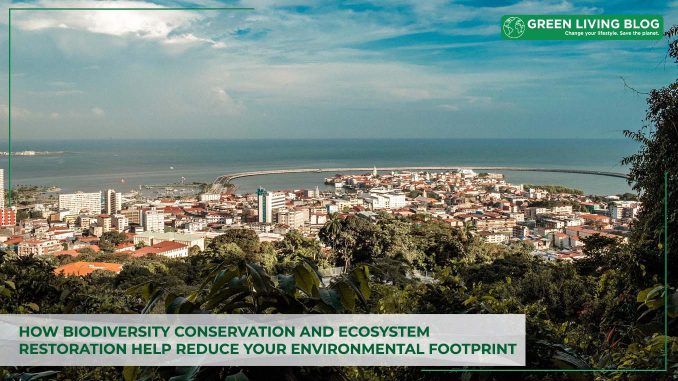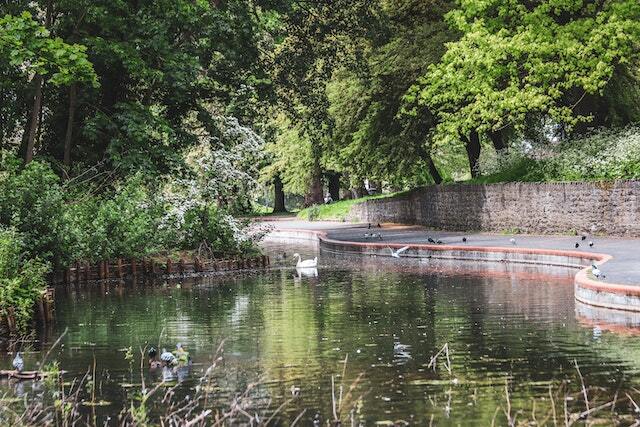
Biodiversity conservation and ecosystem restoration are essential pillars in safeguarding our planet’s vitality and resilience. As humanity faces unprecedented environmental challenges, these interconnected concepts offer promising avenues to protect and restore the delicate balance of life on Earth.
Biodiversity, encompassing the intricate web of species and their interactions, forms the foundation of thriving ecosystems. Meanwhile, ecosystem restoration strives to undo the damage inflicted on these ecosystems, rekindling their vitality and harnessing their potential to provide invaluable services.
We delve into the critical practices underpinning biodiversity conservation and ecosystem restoration, unravelling their significance in propelling sustainability for both the global community and the planet itself.
Why is Biodiversity Conservation and Ecosystem Restoration important?

Biodiversity conservation and ecosystem restoration are not just admirable pursuits; they are imperative actions that resonate across the tapestry of life on Earth.
These endeavours are a testament to our commitment to preserving the intricate web of life and nurturing the ecosystems that sustain it.
Their significance spans a multitude of reasons, each contributing to the complex balance that maintains our planet’s health and its inhabitants’ well-being.
1. Provision of Essential Ecosystem Services:
Biodiversity and thriving ecosystems form the bedrock of numerous indispensable services that underpin human survival and prosperity. These provisioning services range from the tangible, such as providing food, clean water, and fertile soil, to the less substantial yet equally crucial, like climate regulation, pollination of crops, and nutrient cycling. As ecosystems thrive, they supply a buffet of benefits that humanity relies upon for sustenance and development.
2. Enabling Human Wellbeing and Resilience:
The well-being of human societies is intricately linked to the health of the ecosystems surrounding them. Biodiversity-rich environments offer many resources that support livelihoods, ensure food security, and promote physical and mental health. Moreover, thriving ecosystems bolster resilience against natural disasters and the impacts of climate change, acting as a buffer against the uncertainty of a rapidly changing world.
3. Contribution to Sustainable Development Goals (SDGs):
The pursuit of the Sustainable Development Goals finds a powerful ally in biodiversity conservation and ecosystem restoration. These efforts align seamlessly with SDGs such as poverty eradication, zero hunger, clean water and sanitation, climate action, life below water, and life on land. By investing in the health of ecosystems, we concurrently address a multitude of global challenges, fostering a more equitable and sustainable world for all.
4. Safeguarding Evolutionary Potential:
Life on Earth is in a perpetual state of evolution, enabling organisms to adapt to new environmental conditions and emerging challenges. Biodiverse ecosystems serve as reservoirs of genetic diversity, offering the raw materials necessary for species to evolve and thrive in the face of changing circumstances. The preservation of this evolutionary potential ensures that life can navigate the unknown paths that lie ahead.
What are some of the best Practices for Biodiversity Conservation and Ecosystem Restoration?

In the intricate tapestry of our planet’s ecosystems, no single solution can encompass our diverse challenges.
Biodiversity conservation and ecosystem restoration demand a nuanced, context-specific approach that harmonises with each environment’s unique characteristics and needs.
While the paths may vary, several overarching best practices emerge as guiding beacons to navigate this complex journey.
1. Prioritising Conservation and Restoration Efforts:
The vast array of ecosystems and species necessitates a strategic approach to resource allocation. Identifying the most invaluable and threatened ecosystems and species allows for targeted conservation and restoration actions. By focusing on the ecological jewels at risk, we maximise the impact of our efforts.
2. Embracing Ecological Restoration Principles:
Sound ecological knowledge is the compass that steers effective restoration. Stakeholder engagement and local community involvement ensure that actions are harmonious with cultural values and societal needs. Regular monitoring and evaluation of outcomes and adaptability in response to changing circumstances enhance the likelihood of success.
The United Nations General Assembly’s declaration of 2021-2030 as part of the United Nations Decade on Ecosystem Restoration marks a significant step towards addressing the global environmental challenges we face. This initiative recognizes the urgency of restoring ecosystems, which are crucial for biodiversity conservation, climate mitigation, and overall sustainable development.
3. Harnessing Nature-Based Solutions:
With its inherent resilience, nature offers solutions that resonate with its rhythms. Restoration of natural habitats, bolstering green infrastructure, promoting sustainable land use practices, and combating pollution are strategies rooted in the wisdom of the natural world. Through these actions, we collaborate with nature, amplifying its rejuvenation potential.
4. Mainstreaming Conservation and Restoration into Governance:
From local to global levels, embedding biodiversity conservation and ecosystem restoration within policies, plans, and budgets transforms these practices into enduring commitments. Integrating these principles across governance structures ensures a holistic approach that nurtures the environment and the societies it sustains.
5. Strengthening the Institutional Framework:
Enforcement of environmental laws, establishing protected areas and corridors, and creating economic incentives for ecosystem services bolster the foundation of conservation and restoration efforts. Mobilising resources from both public and private sources galvanised the financial muscle needed to drive change.
6. Fostering Collaboration and Interdisciplinary Synergy:
The journey towards conservation and restoration is not a solitary endeavour. Fostering cooperation among sectors, disciplines, and actors widens the tapestry of ideas and expertise. Partnerships, networks, and platforms for knowledge exchange transform individual efforts into a powerful collective force.
By following these best practices for biodiversity conservation and ecosystem restoration, we pave the way for a greener future that benefits all generations.
What are some innovative Examples of Biodiversity Conservation and Ecosystem Restoration Projects?
There are many examples of successful biodiversity conservation and ecosystem restoration projects around the world that demonstrate the benefits of these practices.
The UK Centre for Ecology & Hydrology (UKCEH) stands as a beacon of excellence in environmental science.
Website: https://www.ceh.ac.uk/our-science/science-challenges/ecosystem-restoration-and-resilience
Social Media: Linkedin – Twitter – Facebook – Youtube
In a world grappling with environmental challenges, the International Union for Conservation of Nature (IUCN) and its initiative of the United Nations Decade on Ecosystem Restoration emerge as a clarion call to action.
View this post on Instagram
From 2021 to 2030, this transformative initiative challenges us all to embark on a journey of monumental proportions – a journey that holds the promise of rejuvenating our ailing ecosystems and reshaping the trajectory of our planet’s future.
Website: https://www.iucn.org/our-work/topic/ecosystem-restoration
Social Media: Linkedin – Facebook – Instagram – Youtube
The 10 Ways to Conserve Biodiversity project by Greentumble suggests various actions individuals and communities can take to protect biodiversity at different levels.
Did you know that 7 years ago we developed the concept of Greentumble & published first articles?
One of the oldest pieces on our website is this one: https://t.co/xX0Lm3587P pic.twitter.com/VrvcifkxHd
— Greentumble (@Greentumble) June 25, 2022
These include supporting government legislation for environmental protection; creating or visiting nature preserves or national parks; reducing invasive species; restoring habitats; participating in captive breeding or seed banks; conducting or supporting research; reducing climate change; purchasing sustainable products; educating oneself or others; or joining or donating to environmental organisations.
Website: https://greentumble.com/10-ways-to-conserve-biodiversity
Social Media: Facebook – Twitter
How can you get involved in Biodiversity Conservation and Ecosystem Restoration?
Amidst the urgency of our times, engaging in biodiversity conservation and ecosystem restoration isn’t just a noble pursuit – it’s a transformational journey with the power to shape our world. Start by arming yourself with knowledge; tap into credible sources to comprehend the ecological state of your surroundings. This awareness lays the groundwork for effective action.
Embrace the spirit of collective effort by joining local or global initiatives. Whether through volunteering, fundraising, or advocating, your involvement magnifies the restoration cause and propels positive change. Simultaneously, integrate sustainability into your daily life – choose organic and ethically sourced products, minimise waste, and adopt renewable energy solutions.
Yet your impact doesn’t end there. Your voice holds the potential to inspire others. Organise events, work with your local community to reduce fly tipping and waste crime, spark discussions and foster a sense of shared responsibility.
Furthermore, take tangible steps towards ecosystem renewal. Plant trees, create environmentally friendly gardens, and sow the seeds of transformation in your community. By embracing these best practices and stepping into action, you cultivate a legacy of environmental rejuvenation.
Each choice you make, every voice you amplify, and every step you take contributes to a more vibrant, resilient, and sustainable planet for current and future generations. Your role is pivotal; your commitment is a catalyst for meaningful change.
Conclusion
In the quest for biodiversity conservation and ecosystem restoration, your and our actions hold the potential to drive impactful change. Learning, advocating, and engaging with the best practices outlined here to make everyone an integral force in revitalising our planet’s health. As we tread the path of sustainability and awareness, remember that our contributions reverberate far beyond, nurturing a world of renewed vitality for all.
![]()
Author Profile
- Online Media & PR Strategist
- Blogger and Educator by Passion | Senior Online Media & PR Strategist at ClickDo Ltd. | Fascinated to Write Lifestyle Blogs in News & Education I have completed a journalism summer course at the London School of Journalism and manage various blogs.
Latest entries
 Green Expert GuidesMarch 28, 2025Lisbon Living: Where Sustainable Charm Meets Urban Energy
Green Expert GuidesMarch 28, 2025Lisbon Living: Where Sustainable Charm Meets Urban Energy EnvironmentJanuary 21, 2025Buying Eco-Friendly Homes: 6 Eco Questions to Ask Your Real Estate Agent
EnvironmentJanuary 21, 2025Buying Eco-Friendly Homes: 6 Eco Questions to Ask Your Real Estate Agent BusinessJanuary 16, 202510 Benefits of used Office Furniture when Refurbishing an Office
BusinessJanuary 16, 202510 Benefits of used Office Furniture when Refurbishing an Office Best practicesJanuary 6, 2025Eco-Friendly Event Planning: Mastering Sustainable Waste Management for Holiday Celebrations
Best practicesJanuary 6, 2025Eco-Friendly Event Planning: Mastering Sustainable Waste Management for Holiday Celebrations






Leave a Reply
You must be logged in to post a comment.